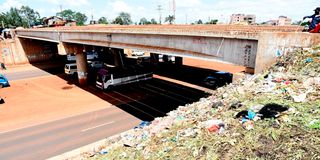Waiyaki Way, the road of incomplete underpasses

The incomplete Kangemi Bridge along Waiyaki Way on January 5, 2022 where pedestrians dodge motorists on the busy highway. Nearly all the 13 underpasses on road are incomplete.
A jersey barrier stretches about 18 kilometres, with openings either welcoming or bidding goodbye to travellers using the Waiyaki Way in Nairobi.
But while ithe highway acts as a landmark of sorts for many, underneath it are tales of tribulations.
Nearly all the 13 underpasses on the stretch are incomplete, even though the connecting roads have been completed.
The Nation team visited underpasses at the Uthiru Junction, Kinoo 87, Kinoo, Muthiga, Rungiri area, Gitaru, Zambezi - Nderi exit, Kiambaa and Tigoni, and the story is the same.
An ideal underpass should be well-lit with a smooth and well-paved surface.
However, from Uthiru Junction Nairobi to Tigoni, only the Gitaru railway bridge was close to an ideal underpass.
The underpasses are filled with deep potholes, filled with water and reeked of raw sewage.
While they were built as a safe way for both pedestrians and motor vehicles, locals have resorted to using the incomplete underpasses highways endangering their lives as they attempt to avoid the poor state of the highway.
In the drive on Waiyaki Way from Westlands to Tigoni, the Nation team spotted an opening every 10 feet on the jersey barrier, where pedestrians must make their way through then cross the busy highway.
Many people and animals –especially dogs—have lost their lives on this stretch of the road.
But Charles Njogu, the assistant director of corporate affairs at the Kenya National Highways Authority (Kenha), says the Waiyaki highway is still under construction.
“That road is still under construction, we have been having challenges with funding, but it’s still under construction,” said Mr Njogu.
At Uthiru Junction, Naomi Wanjiru, a trader, told Nation.Africa that cases of insecurity near the underpasses are many due to the lack of street lights.
“I work here until 5.30 pm or 6 pm because I cannot afford to be here when the night falls; I cannot cross through the highway because of how dangerous it is, so I have to make sure I pass through the underpass, and it is normally safer during the day than it is at night,” said Ms Wanjiru.
“The other day, I witnessed one lady being robbed at the underpass; if they can do that during the day can you imagine what they can do during nightfall.”
A 2018 Northern Corridor and Nairobi County Route Hazard Mapping Report revealed that Nairobi has the highest number of dangerous roads.
And according to the National Transport and Safety Authority (NTSA), 4,432 people died in road accidents between January 1 and November 15, 2022.
According to the safety agency, pedestrians account for the highest number of fatalities.
“it is tricky; if you miss any turn, you find yourself in Tigoni (some 27km from Nairobi city centre). I cannot tell you how many times I have missed a turn. Waiyaki Way is made for those going on long distances,” said Kevin Namulala, a resident of Nairobi.
Morris Gitonga, however, says the underpasses are a safe space for the boda boda riders and pedestrians.
But he wants the government to complete their construction.
“Underpasses help only during the day because at night it becomes riskier. If I have a customer and it is 7pm, I would rather use the highway rather than risk being mugged or something else. It will be good if the government makes it clear whether they have finished constructing this road and if so, tell us why the underpasses unfinished,” said Mr Gitonga in Muthiga.
On June 30, 2022, the State Department of Infrastructure exceeded its development budget by Sh6.2 billion, a month to the end of the financial year, amid a race to complete President Uhuru Kenyatta’s legacy projects.
The exchequer statistics, published by former Treasury CS Ukur Yatani, show expenditure on the construction of roads and bridges amounted to nearly Sh69.25 billion in 11 months that ended May against a revised budget of Sh63.04 billion for the entire fiscal year.
This translates to 9.84 percent over-expenditure, which is close to the 10 percent legal limit under section 36(9) of the Public Finance Management (National Government) Regulations, 2015.





